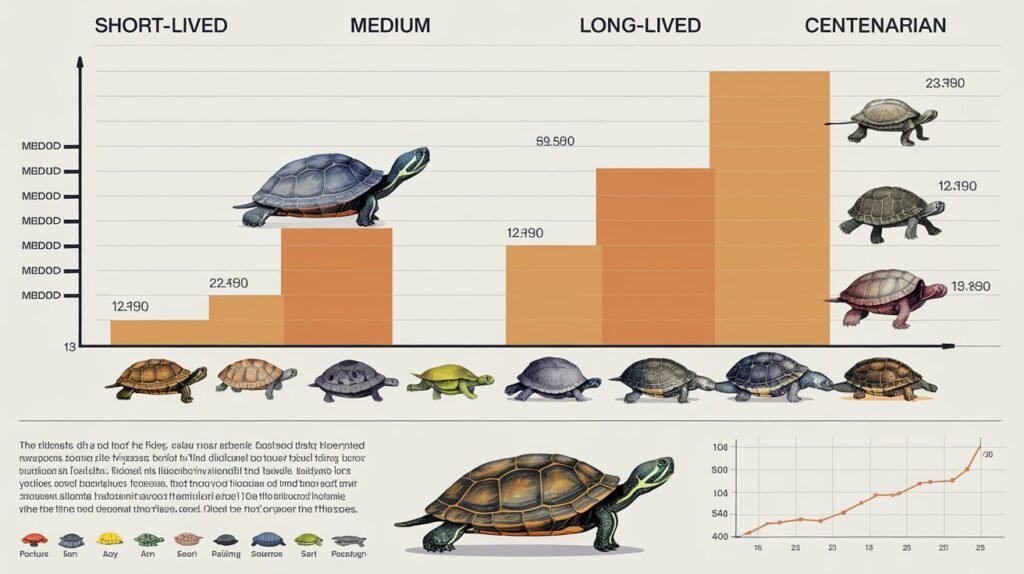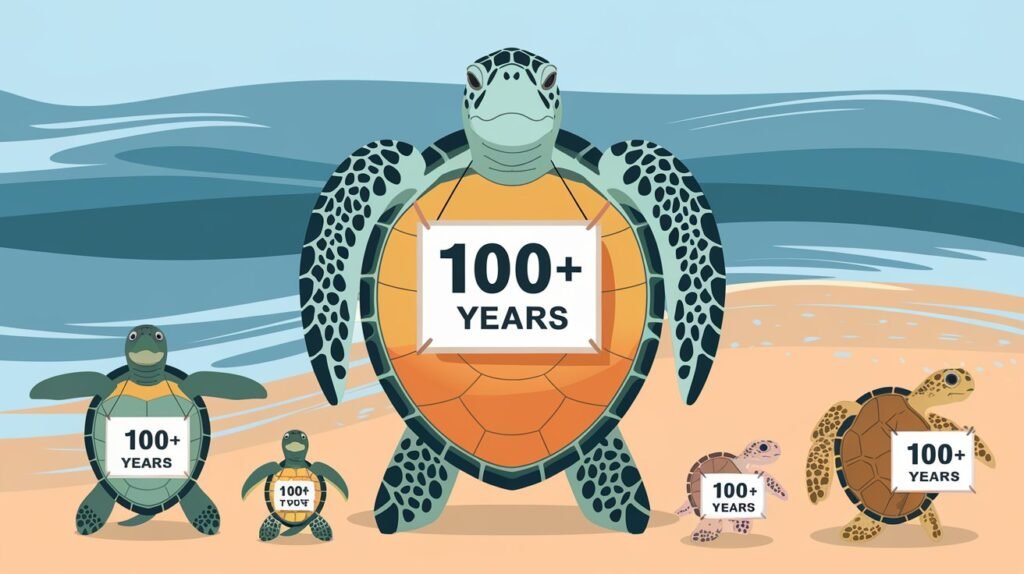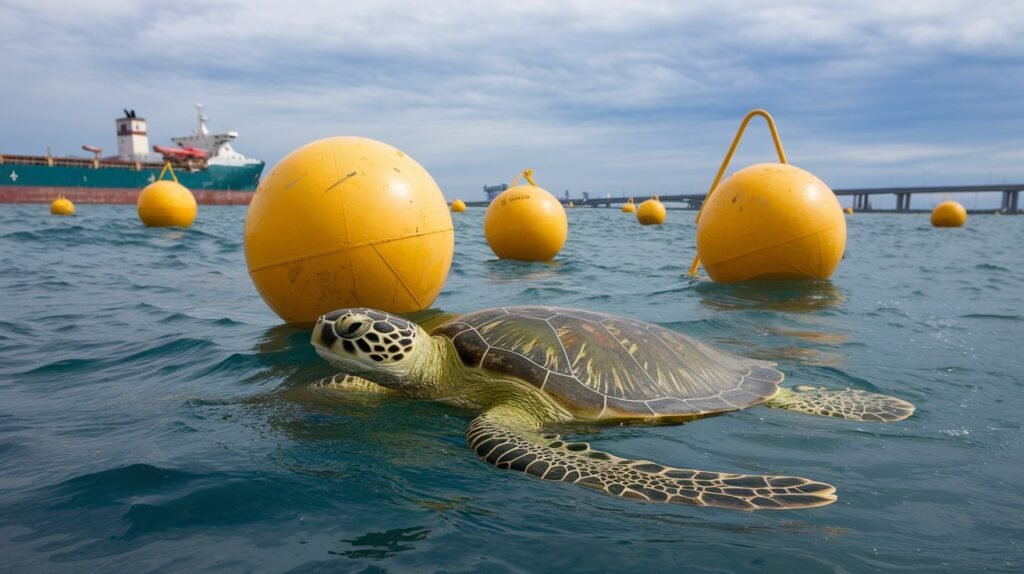Turtles have long captivated our imagination with their ancient appearance and unhurried pace of life. These remarkable creatures, with their distinctive shells and gentle demeanor, seem to embody the very essence of longevity. But just how long do turtles really live? In this article, we’ll dive deep into the world of turtle lifespans, exploring the factors that influence their longevity and uncovering the secrets behind their impressive ability to stand the test of time.
Factors Affecting Turtle Lifespan
When it comes to how long turtles live, it’s not a one-size-fits-all answer. Several factors play crucial roles in determining a turtle’s lifespan:
Species Variations
Just as different breeds of dogs have varying lifespans, different turtle species can live for dramatically different lengths of time. Generally speaking, we can divide turtles into three main categories:
- Sea turtles
- Freshwater turtles
- Tortoises
Each of these groups has its own typical lifespan range. Interestingly, size often correlates with longevity in the turtle world. Larger species tend to live longer than their smaller counterparts. For example, the massive Galápagos tortoise can live well over a century, while a small box turtle might live for 30-40 years.
Environmental Factors
The environment in which a turtle lives plays a huge role in determining its lifespan. Here are some key environmental factors:
- Natural habitat vs. captivity: Turtles in the wild face numerous challenges that can shorten their lives, such as predators, habitat loss, and pollution. On the other hand, captive turtles, when properly cared for, can often outlive their wild counterparts due to regular feeding, veterinary care, and protection from predators.
- Diet and nutrition: A well-balanced diet is crucial for turtle health and longevity. In the wild, turtles naturally seek out the foods they need. In captivity, it’s up to their human caretakers to provide a proper diet. Poor nutrition can lead to health issues that shorten a turtle’s life.
- Predators and threats: While adult turtles have few natural predators thanks to their protective shells, they face numerous threats throughout their lives. Young turtles are particularly vulnerable. Human activities like pollution, habitat destruction, and accidental capture in fishing nets pose significant risks to turtle populations.

Average Lifespan of Different Turtle Species
Now that we understand some of the factors influencing turtle longevity, let’s look at the average lifespans of various turtle species:
Sea Turtles
Sea turtles are some of the longest-lived turtle species. However, their exact lifespans are difficult to determine due to their ocean-going lifestyle.
- Leatherback sea turtle: These giants of the sea turtle world are estimated to live 30-50 years on average, though some may live much longer.
- Green sea turtle: Green sea turtles have an average lifespan of 60-70 years, with some potentially reaching 100 years or more.
- Loggerhead sea turtle: These turtles typically live 50-60 years, though again, some individuals may surpass this.
It’s worth noting that these are estimates based on the best available data. The challenges of tracking sea turtles throughout their long lives make precise lifespan determinations difficult.
Freshwater Turtles
Freshwater turtles, which live in ponds, lakes, and rivers, generally have shorter lifespans than their sea-dwelling cousins, but can still live for impressive lengths of time.
- Red-eared slider: This popular pet turtle species typically lives 20-30 years, though some have been known to reach 40 years of age.
- Painted turtle: These colorful turtles usually live 20-25 years in the wild, but can reach 30-40 years in captivity.
- Snapping turtle: Known for their powerful jaws, snapping turtles can live 30-50 years on average, with some individuals potentially reaching 100 years.
Tortoises
Tortoises, the land-dwelling cousins of turtles, are renowned for their longevity. Some tortoise species hold the record for the longest-lived vertebrates on Earth.
- Aldabra giant tortoise: These impressive creatures can live well over 100 years, with some individuals reportedly reaching 150 years or more.
- Galápagos tortoise: Perhaps the most famous long-lived species, Galápagos tortoises can live over 100 years in the wild. The oldest confirmed Galápagos tortoise lived to be 175 years old!
- Russian tortoise: A popular pet species, Russian tortoises typically live 50-80 years, though some may reach a century.

Record-Breaking Turtle Lifespans
While average lifespans give us a general idea of turtle longevity, some individuals have far exceeded typical expectations. These record-breakers capture our imagination and push the boundaries of what we thought possible for turtle lifespans.
One famous example is Adwaita, an Aldabra giant tortoise that lived in the Alipore Zoological Gardens of Kolkata, India. Adwaita is believed to have lived for about 255 years, finally passing away in 2006. While the exact age is difficult to verify, if accurate, this would make Adwaita one of the longest-lived animals in recorded history.
Another notable long-lived turtle was Tu’i Malila, a radiated tortoise that was reportedly given to the royal family of Tonga by Captain James Cook in 1777. Tu’i Malila lived to the impressive age of 188 years, passing away in 1965.
It’s important to note that verifying extreme age claims in turtles can be challenging. Unlike mammals, turtles don’t have easily countable growth rings in their bones. Additionally, for very old specimens, accurate records may not exist for their early years. Scientists use a combination of historical records, size measurements, and in some cases, carbon dating to estimate the ages of extremely old turtles.
The Science Behind Turtle Longevity
What makes turtles capable of such impressive lifespans? The answer lies in a combination of biological and genetic factors that have evolved over millions of years.
Biological Factors
- Slow metabolism: Turtles have a remarkably slow metabolism compared to many other animals. This means they use energy very efficiently and experience less wear and tear on their bodies over time.
- Shell protection: The turtle’s iconic shell provides excellent protection against predators and environmental hazards, significantly reducing the risk of fatal injuries.
- Ability to hibernate: Many turtle species can enter a state of brumation (similar to hibernation) during cold months. This allows them to conserve energy and survive harsh conditions that might otherwise be fatal.
Genetic Factors
Recent scientific research has uncovered some fascinating genetic adaptations that contribute to turtle longevity:
- DNA repair mechanisms: Turtles appear to have enhanced abilities to repair damaged DNA. This helps prevent the accumulation of genetic errors that can lead to aging and disease.
- Telomere length: Telomeres are protective structures at the ends of chromosomes that shorten as cells divide, eventually leading to cell death. Some studies suggest that turtles may have mechanisms to maintain telomere length, potentially slowing the aging process.
Caring for Turtles to Maximize Lifespan
For those keeping turtles as pets or in conservation programs, providing proper care is crucial to ensuring these animals reach their full lifespan potential. Here are some key aspects of turtle care:
- Proper diet and nutrition: Different turtle species have different dietary needs. Generally, a mix of plant matter and protein sources is important. Consult with a veterinarian or reptile specialist to determine the best diet for your specific turtle species.
- Habitat maintenance: Whether aquatic or terrestrial, turtles need a clean, spacious environment that mimics their natural habitat as closely as possible. This includes proper temperature regulation, UVB lighting for vitamin D synthesis, and appropriate substrate.
- Regular veterinary check-ups: Just like any pet, turtles benefit from regular health check-ups. A reptile-savvy veterinarian can catch and treat potential health issues early, contributing to a longer, healthier life for your turtle.

Conservation Efforts and Their Impact on Turtle Lifespans
While some turtles can live extraordinarily long lives, many turtle species face significant threats in the wild that can dramatically shorten their lifespans. Understanding these threats and the conservation efforts to address them is crucial for ensuring the long-term survival of turtle species.
Threats to wild turtle populations
- Habitat loss: As human populations expand, turtle habitats are being destroyed or fragmented. This can lead to decreased food availability, increased predation, and disrupted breeding patterns.
- Pollution: Marine pollution, particularly plastic waste, poses a severe threat to sea turtles. Many turtles die from ingesting plastic or becoming entangled in discarded fishing gear.
- Climate change: Rising temperatures can affect turtle nesting sites, potentially skewing gender ratios (as temperature determines the sex of developing turtle embryos) and reducing hatching success rates.
- Poaching and illegal trade: Some turtle species are hunted for food or captured for the illegal pet trade, significantly impacting wild populations.
Conservation programs and their success stories
Fortunately, numerous conservation programs around the world are working to protect turtle populations and their habitats. These efforts often focus on:
- Habitat protection: Establishing protected areas and marine reserves to safeguard crucial turtle habitats.
- Nest protection: Monitoring and protecting turtle nesting sites to ensure successful hatching.
- Rescue and rehabilitation: Caring for injured turtles and releasing them back into the wild.
- Education and awareness: Informing the public about the importance of turtle conservation and how they can help.
One notable success story is the recovery of the Kemp’s ridley sea turtle. This species was on the brink of extinction in the 1980s, with only a few hundred nesting females remaining. Thanks to intensive conservation efforts, including protected nesting beaches and the use of turtle excluder devices in fishing nets, the population has significantly increased. While still endangered, the Kemp’s ridley has made a remarkable comeback, demonstrating the potential impact of dedicated conservation work.
Conclusion
The world of turtle longevity is a fascinating one, filled with impressive feats of survival and adaptation. From the century-spanning lives of giant tortoises to the decades-long journeys of sea turtles, these remarkable creatures have much to teach us about the nature of life and aging.
As we’ve explored, turtle lifespans can vary greatly depending on species, environment, and individual circumstances. While some turtles may live only a few decades, others can surpass the century mark, with a few exceptional individuals living well over 200 years.
Understanding the factors that contribute to turtle longevity – from their slow metabolism and protective shells to their enhanced DNA repair mechanisms – not only helps us better care for these animals but also provides insights that could potentially benefit human health and longevity research.
However, it’s crucial to remember that many turtle species face significant threats in the wild. Conservation efforts are vital to ensure that these ancient creatures continue to grace our planet for generations to come. By protecting turtle habitats, reducing pollution, and supporting conservation programs, we can help ensure that turtles continue to live out their impressively long lives in the wild.
As we marvel at the longevity of turtles, let’s also take inspiration from their slow and steady approach to life. Perhaps there’s a lesson for us all in the turtle’s unhurried pace and remarkable ability to withstand the test of time.
